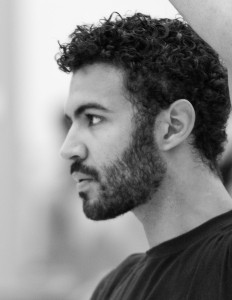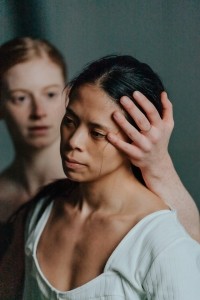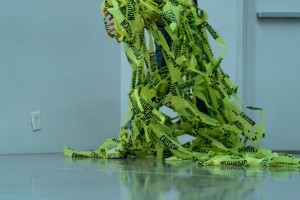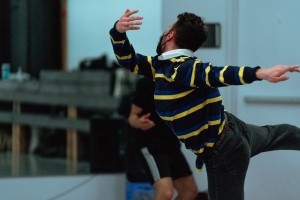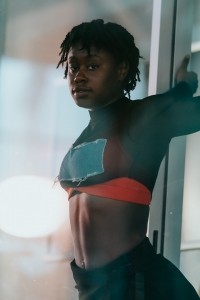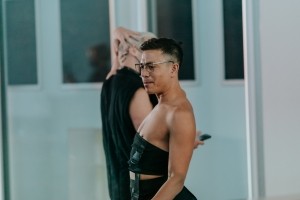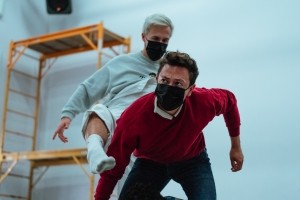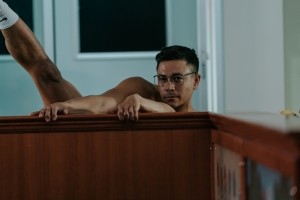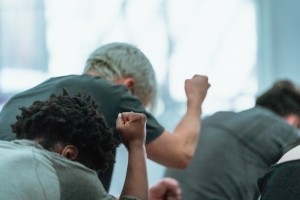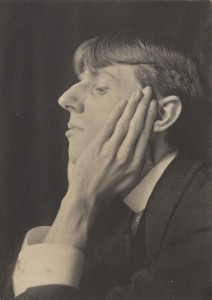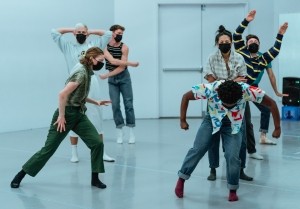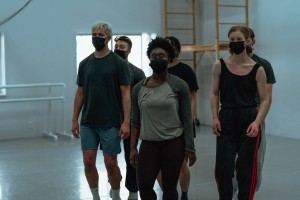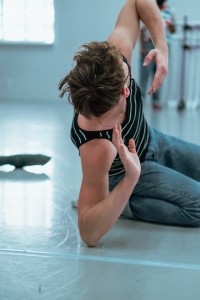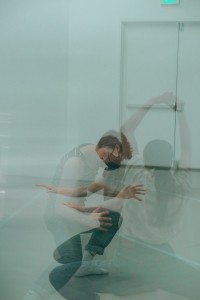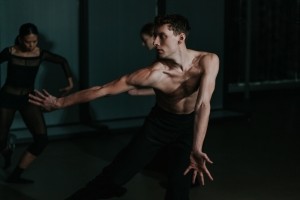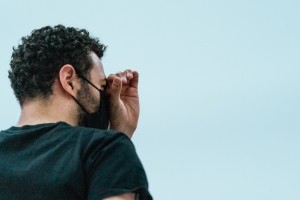Sitting down to write this post, I realized that I had a wealth of material in hand—two websites, choreographer conversations, my notes from a studio rehearsal (dancers masked) and parts of two filming sessions (unmasked), as well as many beautiful still photos by Stefano Altamura with which to illustrate the second work of Joseph Hernandez for Whim W’Him. But since a filmed piece is often shot piecemeal rather than in run-throughs of the whole work, the scenes I saw when I was there were not those Stefano photographed. Different movement, costumes, characters and configurations. So, below are some written impressions and background on what I observed, while the images are mostly chosen for other than illustrative purposes from Stefano’s gallery.
In a roughly circular group of six, the dancers stand facing inward. Joseph ties the end of a large roll of yellow caution tape to one of Andrew McShea‘s wrists and winds it among the other dancers, unreeling it around shoulders, ankles, backs and arms until they are tied up in a ragged bundle, though still separate from each other. Finally, he tears off the tape from the roll and securing the end to Andy’s other wrist.
Is it a crime scene or hazardous work site? the portrayal of the workings of a demented spider? a Maypole dance gone mad? an adult version of cat’s cradle…?
The dancers start to move, painstakingly unwinding themselves from the tape with the same deliberate absorption, as if the whole sequence were predestined. At last, after much effort, all are liberated. They exit.
The tape remaining in a heap on the floor is not entirely inanimate. It conceals, more or less, a male human body (Andrew’s) clad only in flesh-colored briefs, which struggles to extricate itself.
Untitled Aubrey Beardsley Dance Suite For Film or How to Make Art at the End of the World (UABDS FF, for short) is the full name of the piece. Like a scrambled radio signal with so much static the message can’t get through or is only heard in snatches, hearing (and understanding) in snatches seems to be central to the experience of this new work.
Everything about the project, its genesis and its on-going execution is out of the ordinary. When the pandemic struck, Joseph found himself unable to dance or work. The Dresden Semperoper Ballett for which he has often contributed work soon went on lockdown, but quite aside from places that commission his creations, he was struck by grave misgivings about the whole enterprise of making dance. For a long time Joseph had been wondering how to work in art. With the onset of Covid 19, he found himself seriously questioning its very meaning and purpose. Is art just a waste of time? Or does its grappling with life make it indispensable? “There is beauty and there are things to be revered for that quality alone,” he thought, “but not in my work.” Such ruminations were the seed corn for UABDS.
Jim Kent is dressed as a character he has played with variations in several Whim W’Him pieces by different choreographers. An earnest fellow, this time in jeans with rolled cuffs, a cranberry red sweater, leather shoes, glasses and a serious manner, he sports large earphones on his head. As he delivers an indistinctly heard monologue—about art and life and intentionality and sexuality and displacement—other dancers move in behind him, clad in wildly different garments (long pants & tank tops, black & white zigzag sequins, head to toe leather—there is a common thread of gender-bending or blending in UABDS, men in women’s clothes, esp. The other way around is harder to decipher).
Jim walks about the space, around a tall panel, caught up in a philosophical disquisition with himself. As he he moves, and even gets down on the ground where the other dancers circle around him and over and under him, his full concentration is on his own words (which are actually being delivered to him before he says them by a robotic voice through the earphones from his computer). Jim says it’s remarkably hard to marshal the intense focus needed to hear and say the words with expression so they make sense, while keeping alert at each instant for the next phrase, in a kind of simultaneous translation. He takes no notice whatsoever of the other figures gyrating around him.
Jim in his same garb is seated on a desk chair at a wooden table with a dead plant on it. Facing him is Karl Watson, scarcely recognizable in his recently silver-white-dyed hair, an elegant calf-length dress with a gold brooch, fishnet stockings and very high heels. An initially polite conversation grows increasingly heated on the relation of art to the past and of present art to previous. (“Alternatively…” “Or put another way…” “All that said…” “Expressed differently…”) Once again, there is a radical disjuncture between the speaking characters and the dancers behind them, even when the latter intrude urgently into the talkers’ space.
Michael Arellano is in the bath. One leg, his face in sunglasses, and part of his bare torso are visible above the rim of a children’s wading pool (though the picture above that suggests the pose was taken of Jim in a different scene). Karl, still in black dress and heels, paces and talks into a cell phone, maybe ordering food? “…without salad—no no no no, Marco says it must be without salad”— or, no no no, it seems he is referring to piece of art to be shown (perhaps?) in a gallery… Or at least that’s what I thought he said…
When Karl is doing that scene, he his saying “without the phallus”. Beardsley famously added phallic imagery to his drawings and it made them upsetting to a lot of people. I liked your interpretation and it its just as valid as the intention, but I felt like I wanted to say that.]
In the spring and summer of 2020, Joseph (in Dresden, Germany) held weekly Zoom meetings with dramaturg/archivist Dana Offenbacher (librarian trained in information sciences in New York) and Barret Anspach (composer in Seattle). They put together a website of academic musings, music, questions, ideas for movement. Across many months they worked out the theoretical framework of a new piece in three forms, “Film, Internet, and Theatre.” Of the piece that was coming into focus, though still in words not dance, the website has this to say:
“UABDS FF is inspired by English illustrator and author Aubrey Beardsley (1872-1898) as a historic figure, but also as a totemic guide to creation. Diagnosed with TB in childhood Beardsley, knew he would die young. This knowledge informed his entire life. UABDS pulls from facts of his life and work in a search for meaningful parallels with contemporary problems. The piece aims at reimagining/honouring Beardsley’s legacy, thus celebrating the role of the contemporary artist in all its iterations. To interact with Beardsley’s work is to interact with something that is altogether design-oriented while also being gutsy and naughty. Definably camp, his work created one of the first queer shibboleths of the 20th century. As artists in 2021, we have begun to feel as though we are working with a narrowing time limit. Not only is our physical safety more obviously in danger, but our tenuous relationship to reality (by way of contemporary media habits) threatens the way that we process this danger. It has begun to feel as though the systems that we rely upon to understand the enormous complexities of our species have started to cannibalize themselves. The concept of societal collapse has changed from something that used to be seen as vaguely plausible (if somewhat fashionable to think about) to a near mathematical certainty. We find that this fact hangs over the act of creation at every stage.”
Another website, sent ahead to the dancers in Seattle, brimmed with dozens of questions from light-hearted (What colour is the internet?) to probing (Which ancient greek figure is most like your mother? Real or imagined), about life, art, the present moment, making dance—as well as suggestions, ruminations and movement prompts for them to think over and work with in advance of his arrival. It began:
This is a collection of exercises, lists, and images that (should) help in the creation of the UABDS FF. I am writing this because I am impatient to start, and I believe that it would be helpful to have something down on paper that we can all look at, with the option to ignore it later. I am excited to be in the same place with all of you, and I really enjoy input from all places – so this is, by no means, intended to generate the only content for the piece. The information presented here is organised in order of priority/relevance to the piece. It is all somehow relevant, but the document has become much longer than anticipated and the last thing I want to do is lose you to my unevenly distributed, meandering, linguistic potholes.
When Joseph actually did get to Seattle, along with Dana, to create in person with the Whim W’Him dancers, they already had a great jumble of material, to which they had added their own ideas. In the studio with the dancers in person at last, together they developed scenes, movements and characters designed specifically by and for this group of seven on the themes earlier explored by Joseph and his two collaborators.
All the film sequences, now in the editing stage, were shot in a former Old Navy store in Seattle’s Northgate Mall, furnished with tall slightly translucent panels and a strange conglomeration of stored or discarded items. It’s a huge space with a rather eerie and mysterious vibe. Whim W’Him artistic director Olivier Wevers fantasized over it. “This would make a fantastic rehearsal space,” he mused. “You could have three studios…” In fact, it will soon be transformed into the Kraken NHL offices and training center.
Dancers in a tight-knit black-clad group face Andrew a few yards away. He, in what he calls ‘my prairie dress’ (white, long sleeves, a ruffled hem) is having some sort of seizure or fit, making strangled sounds, until he falls to the floor motionless. The group, still and unmoved, waits until he seems clearly dead before exiting, in the same group formation facial expression still deadpan. After a few seconds, Andrew stirs, opens his eyes, sits up, gets to his feet and leaves himself, seemingly none the worse for his near-death experience.
The plot of UDABS became even murkier at an in-person Whim W’Him performance, one of three held last weekend at the Vashon Center for the Arts, where short videos also recapped this year’s filmwork and revisited Of Then and Now by Ihsan Rustem plus artistic director Olivier Wevers’s Monster. Fittingly, UDABS was itself presented with a combination of media. Serious and tongue-in-cheek, wordy and wordless. A multiplicity of meanings. Take your pick.*
There were still photos, video, and written statements/queries/musings projected on a screen. And live performance—of excerpts from UDABS, a new creation by dancer Karl Watson, as well as FLOCK‘s Nova.**
Real dancers on a real stage in real time! Three dimensions with light glinting on rounded bodies, moving instant to instant. A sensational sensation. Dance has never seemed more live.
At present we are in a sort of hybrid moment for the performing arts: the brief illuminations of in-person performances-to-come flicker like lightning flashing over a darkened landscape; meanwhile the combined cinematic eye (of choreographers and videographer Quinn Wharton) shapes the common material into a different and quite uncommon kind of revelation. In an ideal world, we could see both.
*Case in point: I sent Joseph an email draft of this post, to which he replied from Germany: When Karl is doing that scene, he is saying “without the phallus”. Beardsley famously added phallic imagery to his drawings and it made them upsetting to a lot of people. I liked your interpretation and it its just as valid as the intention, but I felt like I wanted to say that.
Multiplicity of meaning, indeed…
**The filmic versions of UDABS and FLOCK’s Nova will premiere on May 27, 2021 as Wonder Beyond. Check with the IN-WITH-WHIM page on this website for access.
